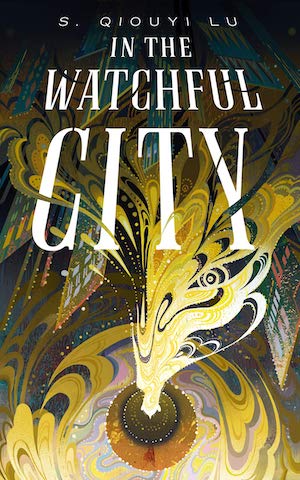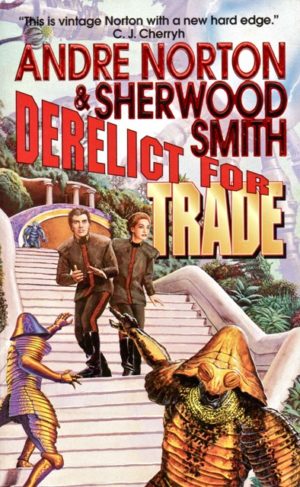After the earnestness of Atlantis Endgame, this entry in the Solar Queen series is quite a lot of fun. Norton’s own solo works in the series feature a somewhat raffish, somewhat beat-up spaceship with a crew of Free Traders and a tendency to fall into the worst kinds of bad luck. “What’s the worst that can happen?” isn’t a rhetorical question for the Queen. Not only does it happen, the crew has to go through complicated contortions to get back out of the mess—and just about every time, they fall right back into a new mess.
The original series is real old-fashioned science fiction, with a protagonist named Dane Thorson and his good friend Rip. But Rip is Black and their frenemy’s name is Ali, and the ship’s cook is Japanese. It’s a diverse crew for a Fifties adventure.
The addition of collaborators further opens up the series. P.M. Griffin co-wrote Redline the Stars (1993), which introduces a female medic, Rael Cofort. Sherwood Smith then took over with Derelict for Trade and A Mind for Trade. Smith adds another, nonhuman character in the first volume, who is also female. The gender balance by that point is still tipped way over toward the male, but it’s a definite start.
As I said, I had fun with Derelict for Trade. It read to me as if Norton gave Smith the keys to the Queen, along with her blessing, and told her to have at it. The result is strikingly similar to Smith’s other collaborative series, Exordium, which she wrote with Dave Trowbridge—and in fact the introductory note acknowledges his contributions to the plotting and setup of this novel. If you’ve read this one and enjoyed it, you’ll probably enjoy Exordium.
There are some characteristic Norton persons and settings. The crew of the Queen is all present and accounted for. The various forays into the Spinner, the dark underbelly of the space habitat in which most of the action takes place, recall many a subterranean quest in many a Norton novel. There are brief cameos featuring the Free Traders’ ancestral enemy, the corporate traders nicknamed I-S, along with a variety of aliens of all shapes, sizes, and degrees of strangeness.
Buy the Book


In the Watchful City
Even so, this seems more like a Smith novel under Norton’s umbrella than a Norton novel or a fifty-fifty collaboration. There’s an actual real romance with actual real physical and emotional development. None of the villains is completely and irredeemably evil, though the main bad is a pretty nasty piece of work. We are still shown how and why he is what he is, and allowed to understand a little bit of what motivates him. The other villains or seeming villains turn out to be not quite as bad as they seemed, and even, eventually, become allies. That’s a fair departure from Norton’s rigorously dualistic universe.
As for the good guys, we see how Dane has started to grow into himself, and how the other characters have grown and changed as well. We even get to see inside the rough-hewn monolith that is Captain Jellico.
And on top of all that, there’s humor. Norton is a very earnest writer. Her characters are very serious people with very serious goals and very serious purposes, often imposed on them by incomprehensible outside forces. There’s nothing in solo Norton like the gleeful slapstick of Dane half-killing himself trying to play the bagpipes at 1.6 Earth gravity while a two-ton alien hews away at him with a broadsword. That’s pure Smith (and not a little Trowbridge).
Norton did love to fill her worlds with wide varieties of aliens, and she often tried to portray minds that differ considerably from human. But Smith adds multiple layers of complexity to the alien characters and species, creating elaborate structures of ritual and custom. The problem the crew have to solve is a complicated web of deception, murder, and high finance, and has to be resolved by high-level computer hacking.
There’s a bit of strain there between Norton’s uber-retro tapes and spools and the kind of computing that would have been the norm by the early 2000s, with chips and bots and computer viruses. The cramped antiquity of the Solar Queen becomes a point of pride for the crew—it may be ancient and tiny especially for tall lanky Dane, but it’s home. The computer question sort of slides off tapes into chips and never quite finds its way back.
Overall I would not call this a Norton novel, nor a particularly seamless collaboration. But it is entertaining, and takes familiar characters into new territory, while keeping the basic principle of the series, which is the hard-luck spaceship that always manages to come out on top in the end. We know it’s going to spiral right back down again in the next installment—and then spiral back up, thanks to the pluck and ingenuity of Dane and his chosen family.
Since my copy of Huon of the Horn has arrived, I’ll reread that next. And then we’ll check out a few more collaborations before we wrap up the Reread.
Judith Tarr has written historicals and historical fantasies and epic fantasies and space operas, many of which have been published as ebooks. She has won the Crawford Award, and been a finalist for the World Fantasy Award and the Locus Award. She lives in Arizona with an assortment of cats, a blue-eyed dog, and a herd of Lipizzan horses.











The problem for Norton in these hand-overs is they really highlight Norton’s weaknesses as a writer.
For those who use Amazon Kindle, STAR SOLDIERS and TIME TRADERS are free right now.
@1 I like to think of it more as, when her collaborations work, the collaborators add their strengths to hers, and we get something that’s more than the sum of its parts.
Ahhhh…. that refreshing Baen art direction. The perfect way to wrap up a Monday!
I’m curious if you’ll tackle 3 The Halfblood Chronicles books coauthored with Mercedes Lackey: The Elvenbane, Elvenblood, and Elvenborn? Sadly the 4th book is still unfinished (due to Andre’s passing) though Mercedes has said she intends to complete it someday.
I did enjoy the lighter take on the Solar Queen here and in the sequel to this.
The Solar Queen books are long time favorites of mine. I wish Sherwood Smith had been given the go ahead to continue the series (assuming she wanted it).
#4: The Elvenbane is interesting, but my instinct is that – as with the present Norton/Smith volume – it’s mostly Lackey and relatively light Norton, and the sequels tilt that balance even further. That said, I quite liked those books. And based on what our hostess has been highlighting relative to Norton’s ongoing themes and tics over the course of this reread, there may well be enough Norton in The Elvenbane to merit a look. And that said, fair warning: this particular book is not quite a doorstop, and I found it a reasonably quick read back in the day. But I’ll stand by a comment I made in my published review back in the day: in some ways, The Elvenbane reads like a trilogy crammed into a single volume.
///
A more general aside relative to Nortonian collaborations in general: I have a now-vague recollection, from the years when I was most actively connected to the professional side of the SFnal network, that Norton’s medical situation in her last years was akin to Marion Zimmer Bradley’s in that she was physically unable to write on a sustained basis. As a result, many if not most of the works published as collaborations during this period would most likely have been almost entirely the work of the second-billed collaborator, with perhaps an outline or notes supplied by Norton and her caretakers.
Some observers also had the impression that Norton’s health issues – and more specifically the associated medical bills – were one of the catalysts for the ongoing wave of collaborations, in that she needed more money to cover expenses than was coming via ongoing royalties. (It’s worth noting in this regard that Norton, while perennially popular with readers, was publishing the majority of her books either with children’s imprints or as paperback originals, and so was probably severely underpaid by comparison to many of the emerging “best-seller” names in mid- to late-20th century SFF.)
And as I recall, there were also some notable kerfuffles in Norton’s final years (and after her passing) regarding the management of both her personal and literary affairs by at least one of her caretakers. While I believe that’s mostly been sorted out by now, it’s possible that further posthumous Norton-related projects have been derailed by the long gap in publication history and/or questions about exactly where the relevant rights eventually landed.
John Bunnel is correct. I was brought in by the editor at the time to resurrect these various series in order to help Andre Norton out of a devastating financial mess, in addition to her health issues. I’d hoped to collaborate on Witch World. Those had been my faves when I was twelve years old–I checked them out constantly from the junior high library–but another collaborator had been found. There were these two series left, so I plumped for those.
Judith Tarr is correct in her surmises; I asked Dave Trowbridge (who also had been a Norton fan when he was a kid) to invent some reason for all the fifties tech, including tube rockets, so his is the credit for those bits.
Norton was a childhood favorite, so I’ve been following the re-read with interest, but I’d stopped reading her before these collaboration/handoffs. That said, I absolutely loved the Exordium, so this has definitely piqued my interest.
About tapes as storage medium in the future: https://techxplore.com/news/2020-12-fujifilm-ibm-unveil-terabyte-magnetic.html